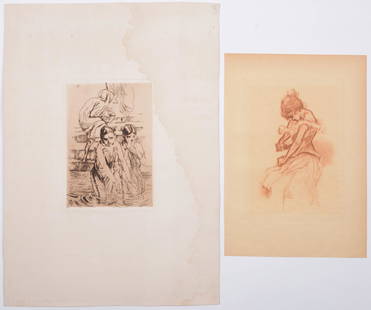Popular Searches
Popular Searches

Etching, Coliseum, Piranesi, Mid-18th c.
Similar Sale History
View More Items in ArtRelated Art
More Items in Art
View More









Item Details
Description
Medium: Etching
Support: Paper
Artist: Piranesi
Artist Dates: 1720-1778
Country of Origin: Italy
Title & Description: "Anfiteatro Flavio detto il Colosseo in Roma"This ink etching depicts the Coliseum in Rome, from the perspective of an observer looking head on from some distance away. A pair of figures can be seen near the center of the image, mostly featureless.
Signature: Bottom Left
Date of Work: Mid 18th C.
Frame: Gilt Wood
Work Size: 5.25x10.25"
Frame Size: 20.25x25.0"
Weight: 6.0lbs
Provenance: Putnam County Estate
Condition: This etching is in excellent condition, with some smudging of the ink used to create it as well as minor foxing.
Artist Biography: Piranesi was born in Mogliano Veneto, near Treviso, then part of the Republic of Venice. His brother Andrea introduced him to Latin and the ancient civilization, and later he studied as an architect under his uncle, Matteo Lucchesi, who was Magistrato delle Acque, a Venetian engineer who specialized in excavation.From 1740 he was in Rome with Marco Foscarini, the Venetian envoy to the Vatican. He resided in the Palazzo Venezia and studied under Giuseppe Vasi, who introduced him to the art of etching and engraving. After his studies with Vasi, he collaborated with pupils of the French Academy in Rome to produce a series of vedute (views) of the city; his first work was Prima parte di Architettura e Prospettive (1743), followed in 1745 by Varie Vedute di Roma Antica e Moderna.The Pyramid of Cestius, etchingFrom 1743 to 1747 he sojourned mainly in Venice where, according to some sources, he often visited Giovanni Battista Tiepolo. He then returned to Rome, where he opened a workshop in Via del Corso. In 1748–1774 he created a long series of vedute of the city which established his fame. In the meantime Piranesi devoted himself to the measurement of many of the ancient edifices: this led to the publication of Le Antichità Romane de' tempo della prima Repubblica e dei primi imperatori ("Roman Antiquities of the Time of the First Republic and the First Emperors"). In 1761 he became a member of the Accademia di San Luca and opened a printing facility of his own. In 1762 the Campo Marzio dell'antica Roma collection of engravings was printed.The following year he was commissioned by Pope Clement XIII to restore the choir of San Giovanni in Laterano, but the work did not materialize. In 1764 Piranesi started his sole architectural works of importance, the restoration of the church of Santa Maria del Priorato in the Villa of the Knights of Malta in Rome, where he was buried in a tomb designed by Giuseppi Angelini.In 1767 he was created a knight of the Golden Spur, which enabled him henceforth to sign himself "Cav[aliere] Piranesi". In 1769 his publication of a series of ingenious and sometimes bizarre designs for chimneypieces, as well as an original range of furniture pieces, established his place as a versatile and resourceful designer. In 1776 he created his famous Piranesi Vase, his best known work as a 'restorer' of ancient sculpture. In 1777–78 Piranesi published Avanzi degli Edifici di Pesto, (Remains of the Edifices of Paestum) a collection of views of Paestum.He died in Rome in 1778 after a long illness and was buried in the Church of Santa Maria del Priorato, on the Aventine hill in Rome.
Buyer's Premium
- 24.5%
Etching, Coliseum, Piranesi, Mid-18th c.
Estimate $50 - $100
9 bidders are watching this item.
Shipping & Pickup Options
Item located in Garrison, NY, usSee Policy for Shipping
Payment

Related Searches
TOP

































![Piranesi Etching of The Pantheon from Views of Rome: Piranesi, Giovanni Battista (Italian, 1720-1778), Veduta del Pantheon d'Agrippa, oggi Chiesa di S. Maria ad Martyres [View of the Pantheon], mid to late 18th century, etching, impression 18.75 x 27.25](https://p1.liveauctioneers.com/184/325324/175081668_1_x.jpg?height=310&quality=70&version=1712331715)
![Piranesi Etching of Roman Forum from Views of Rome: Piranesi, Giovanni Battista (Italian, 1720-1778), Veduta di Campo Vaccino [View of the Campo Vaccino, Roman Forum], mid to late 18th century, etching on laid paper, no watermark visible in the margins](https://p1.liveauctioneers.com/184/325324/175081669_1_x.jpg?height=310&quality=70&version=1712331715)
![Piranesi Etching of Captioline Hill from Views of Rome: Piranesi, Giovanni Battista (Italian, 1720-1778), Veduta del Campidoglio di Fianco [Side View of the Captioline Hill], mid to late 18th century, etching on laid paper, Fin T Dupuy Auvergne watermark,](https://p1.liveauctioneers.com/184/325324/175081666_1_x.jpg?height=310&quality=70&version=1712331715)
![Piranesi Etching of Trevi Fountain from Views of Rome: Piranesi, Giovanni Battista (Italian, 1720-1778), Veduta in Prospettiva della gran Fontana dell' Acqua Vergine detta di Trevi Architettura di Nicola Salvi, [View of the Trevi Fountain], mid to late 18](https://p1.liveauctioneers.com/184/325324/175081670_1_x.jpg?height=310&quality=70&version=1712331715)


























